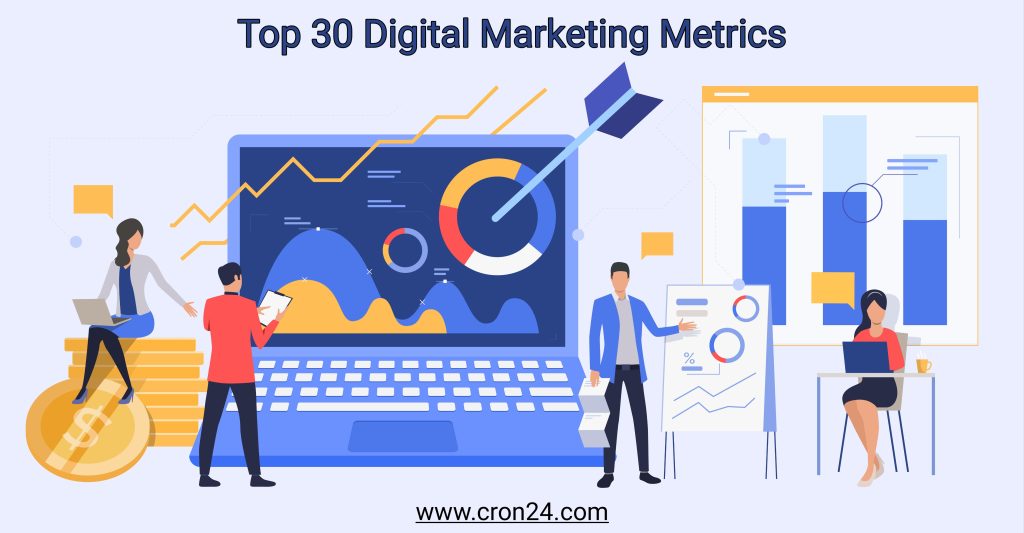Top 30 Key Digital Marketing Metrics - Every Marketers Should Know
Travel

Digital marketing metrics are quantitative measurements used to analyze and evaluate the performance and effectiveness of digital marketing campaigns. These metrics help marketers assess the impact of their strategies, optimize campaigns, and make data-driven decisions. Here are some common types of digital marketing metrics:
1. Impressions: The number of times an ad or content is displayed or viewed by users.
2. Clicks: The number of times users click on an ad, link, or call-to-action button.
3. Search Engine Results Page (SERP) Ranking:
The position of a website or webpage in search engine results pages for specific keywords. It measures the visibility and organic search performance of a website. Monitoring SERP rankings helps evaluate SEO effectiveness and track improvements over time.
4. Click-through Rate (CTR):
The percentage of people who clicked on an ad or link compared to the number of impressions. It measures the effectiveness of an ad in generating clicks.
5. Conversion Rate (CR):
The percentage of users who complete a desired action, such as making a purchase, filling out a form, or subscribing to a newsletter. It indicates the success of a campaign in achieving its objectives.
6. Cost per Click (CPC):
The average cost incurred for each click on an ad. It helps evaluate the cost-effectiveness of paid advertising campaigns.
7. Cost per Acquisition (CPA):
The average cost incurred to acquire a customer or obtain a conversion. It measures the efficiency of marketing efforts in generating conversions.
8. Return on Investment (ROI):
The ratio of the net profit generated from a campaign to the cost of that campaign. It assesses the profitability and effectiveness of marketing initiatives.
9. Bounce Rate (BR):
The percentage of users who visit a webpage but leave without interacting further or navigating to other pages. A high bounce rate may indicate a poor user experience or irrelevant content.
10. Average Session Duration:
The average amount of time users spend on a website or within an app. It reflects user engagement and interest.
11. Social Media Engagement:
Metrics related to social media platforms, such as the number of likes, comments, shares, or followers. These metrics measure the level of audience engagement and brand awareness.
12. Email Open Rate (EOR):
The percentage of recipients who open an email. It evaluates the effectiveness of email marketing campaigns in capturing users' attention.
13. Customer Lifetime Value (CLV):
The predicted net profit a customer is expected to generate over their lifetime as a customer. It helps assess the long-term value of acquiring and retaining customers.
14. Churn Rate:
The rate at which customers stop using or unsubscribe from a service or product. It measures customer retention and satisfaction.
15. Search Engine Rankings:
The position of a website or webpage in search engine results pages for specific keywords. Higher rankings indicate better visibility and organic traffic potential.
16. Customer Acquisition Cost (CAC):
The average cost of acquiring a new customer. It calculates the total marketing and sales expenses divided by the number of new customers acquired within a specific period.
17. Site Engagement Rate (SER):
The level of user interaction with content, such as likes, comments, shares, or time spent on a webpage. It measures the effectiveness of content in capturing and retaining user attention.
18. Customer Lifetime Value/Cost of Customer Acquisition Ratio (CLV/CAC):
The ratio between the customer lifetime value and the cost of customer acquisition. It helps determine the profitability of acquiring customers and their long-term value.
19. Social Media Reach:
The total number of unique users who have been exposed to a social media post or campaign. It measures the potential audience size.
20. Social Media Conversion Rate:
The percentage of social media users who take a desired action, such as making a purchase or filling out a form. It evaluates the effectiveness of social media marketing in driving conversions.
21. Email Click-through Rate (CTR):
The percentage of recipients who click on a link or call-to-action within an email. It measures the engagement and effectiveness of email campaigns.
22. Landing Page Conversion Rate:
The percentage of users who land on a specific web page and complete a desired action, such as making a purchase or filling out a form. It measures the effectiveness of landing pages in driving conversions.
23. Cost per Lead (CPL):
The average cost incurred to acquire a qualified lead. It helps evaluate the efficiency of lead generation efforts.
24. Organic Search Traffic:
The number of visitors who reach a website through organic (non-paid) search engine results. It reflects the visibility and search engine optimization (SEO) performance of a website.
25. Social Media Follower Growth:
The rate at which social media followers or subscribers increase over a specific period. It indicates the growth and engagement of an audience on social media platforms.
26. Customer Satisfaction Score (CSAT):
A metric used to measure customer satisfaction based on surveys or feedback. It helps assess the overall customer experience and loyalty.
27. Page Load Time (PLT):
The time it takes for a web page to load completely. Faster load times are associated with better user experiences and can impact search engine rankings and user engagement.
28. Return on Ad Spend (ROAS):
The revenue generated for every dollar spent on advertising. It measures the effectiveness and profitability of advertising campaigns.
29. Average Order Value (AOV):
The average amount spent by customers per order. It helps evaluate the revenue potential and customer spending habits.
30. Cost per Mille (CPM):
The cost of reaching one thousand impressions or views of an advertisement. It helps evaluate the efficiency of advertising campaigns in reaching a specific target audience.
Lastly, selecting the right metrics that align with your marketing goals is crucial. Regularly tracking, analyzing, and interpreting these metrics provides valuable insights into the performance of your digital marketing efforts. By doing so, you can make informed decisions to optimize and improve your strategies. Remember, the choice of metrics will vary based on your objectives and the channels/platforms you use. So, measure the success and effectiveness of your digital marketing initiatives by selecting and monitoring the appropriate metrics.
Thank you.

